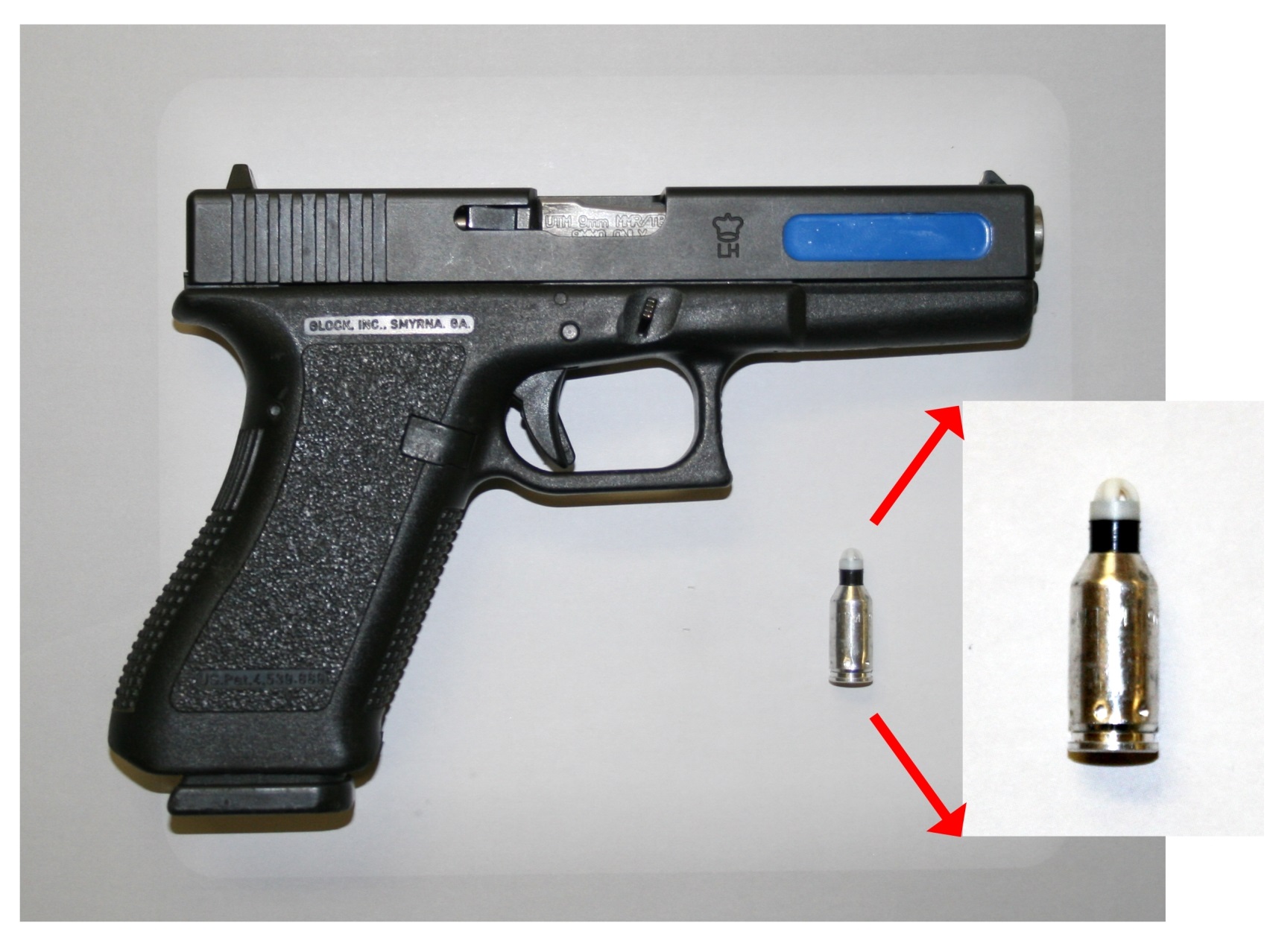
One of the training weapons. Fit and function are identical to a live weapon, but it only fires the non-lethal training cartridge pictured. Cartridge leaves colored marking wax on the target on impact … and maybe a painful welt as a reminder.
In part 1 of this article, I discussed some causes of unintentional discharges (UDs). Since that time, I have had the opportunity to develop and implement an exercise that incorporated some of those causes. I’d like to share the results with you.
The exercise of choice was a force-on-force exercise, which is one of the best tools we have at our disposal to simulate the stress of an actual life-or-death encounter. In force-on-force training, we use specially designed weapons that fire projectiles that hurt when they hit you but won’t kill you. The system we use is not unlike the paintball and Airsoft games that kids (and some adults) play. The difference is our weapons are the actual weapons we carry on a daily basis and the ammunition we fire is a little more painful.
At the start of my deviously designed experiment, I set the students up in a classroom and demonstrated the weapons and ammunition that would be used in the exercise. I intentionally fired a round in the classroom at a cardboard target to show the class how fast and accurate the projectiles were. I made certain to emphasize how much it was going to hurt when one of those rounds struck them. I did my very best to raise their anxiety levels prior to the exercise. The higher I could get their stress levels, the better the training/experiment would be for all of us.
The anxiety caused by the anticipation of something painful is powerful. It’s like knowing you’re going to the doctor’s office to have a procedure that involves a long, thick needle. The wait often causes more stress than the event itself.
Active Shooter Scenario
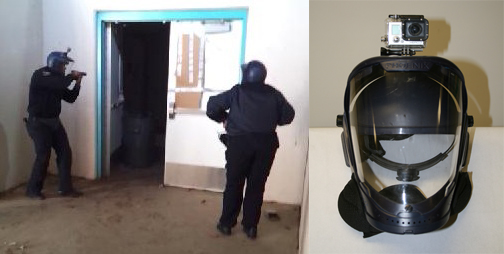
Students in exercise just prior to entering the dark hallway. Student at left is wearing helmet camera shown in larger detail on the right.
The exercise was an active shooter scenario. Students operated in pairs and were told that they were the only responding units to a building where inside an unknown number of perpetrators were killing children. Each student had head and neck protection so they would not be injured in the event one of the projectiles struck in those areas. On one of the two helmets, I mounted my son’s Hero/Gopro camera hoping to get some good video footage of the exercise. I tried to predict which student would provide the most informative video footage and gave that student the helmet with the camera. My predictions were not always correct.
The venue was a hollow, dusty stadium-style building that would make a great haunted house for Halloween. As the officers entered the building, the sensory overload began. Role players were at the far end of the building yelling, screaming and throwing things. One of the role players was equipped with a blank firing shotgun that, when fired, rattled the entire building right down to your fillings. Just as the students entered the building, he’d fire the shotgun a couple of times and then retreat into a darkened hallway. We had loud alarms ringing, and smoke filled the air from the shotgun blanks. My role players continued yelling and screaming inside the darkened hallway until they saw the students’ shadows at the doorway. As the first student entered the dark hallway, the screaming stopped and there was one more loud gunshot that echoed and reverberated down the narrow hall.
Students then had to navigate down the pitch-black hallway using their flashlights. Near the far end, they found that one perpetrator had apparently killed himself as they entered the hallway (that was the last shot fired). The other perpetrator was lying in wait just beyond the body of the first. If the students approached tactically and correctly, they would be able to see the second perpetrator and engage him with a significant likelihood of success. If not, he would emerge from hiding and start firing his machine gun at them.
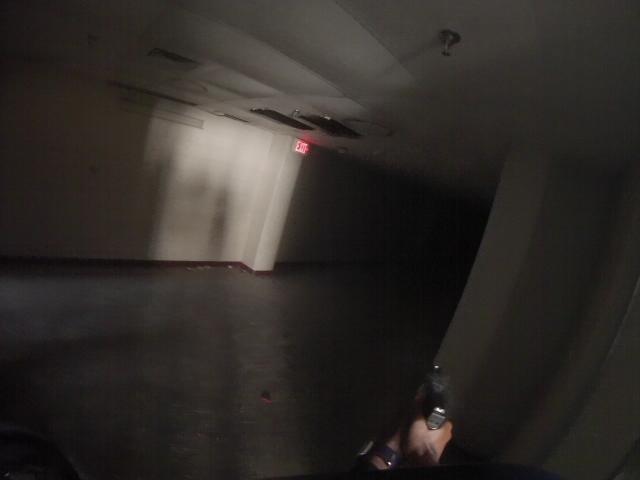
Some UDs occurred as students entered the dark hallway and heard a shot. This is the startle effect.
Out of roughly 25 pairs of students, the other instructors and I noted two unintentional discharges. Both of those took place as the students entered the dark hallway and were surprised by the gunshot. It was a classic startle effect.
What surprised me a little was the fact that I saw that their fingers were off the trigger and along the frame (just as they had been taught) just prior to the unintentional discharge. More surprises were in store for me when I reviewed the videos. Three more students had unintentional discharges that neither instructor had noticed! Even more unbelievable was the fact that one student had a total of three unintentional discharges in less than 25 seconds. In our little experiment, a total of 10% of 50 students committed unintentional discharges and only one of them was aware they had done it.
Incident Analysis
What did we learn? The two most obvious UDs were apparently caused by our old friend the startle effect. However, conventional wisdom has held that if you keep your finger off the trigger and along the frame, that should mitigate the effect of the startle and prevent the UD. While these were admittedly only two observable cases, both students had their fingers along the frame until the startle occurred. My theory on this is that the UD was not caused solely by the involuntary flinching response to the loud noise in a dark hallway. I think the students, whether through fear, anxiety or some other subconscious process, had already committed themselves mentally to firing a shot as soon as a threat presented itself.
The same type of response often occurs in video games, amusement park arcades, and even my old favorite game, Whac-A-Mole. If you are predisposed to execute a specific response to a corresponding stimulus, when a similar but different stimulus appears, the response is often difficult to stop, especially under heightened stress levels. Or in the case of Whac-A-Mole, you are focused on one mole hole, certain that he is about to pop up. When your peripheral vision picks up the mole popping out of another hole, you whack the hole you were focused on instead of the one with the mole. (Whac-A-Mole is a registered trademark of Bob’s Space Racers Inc.)
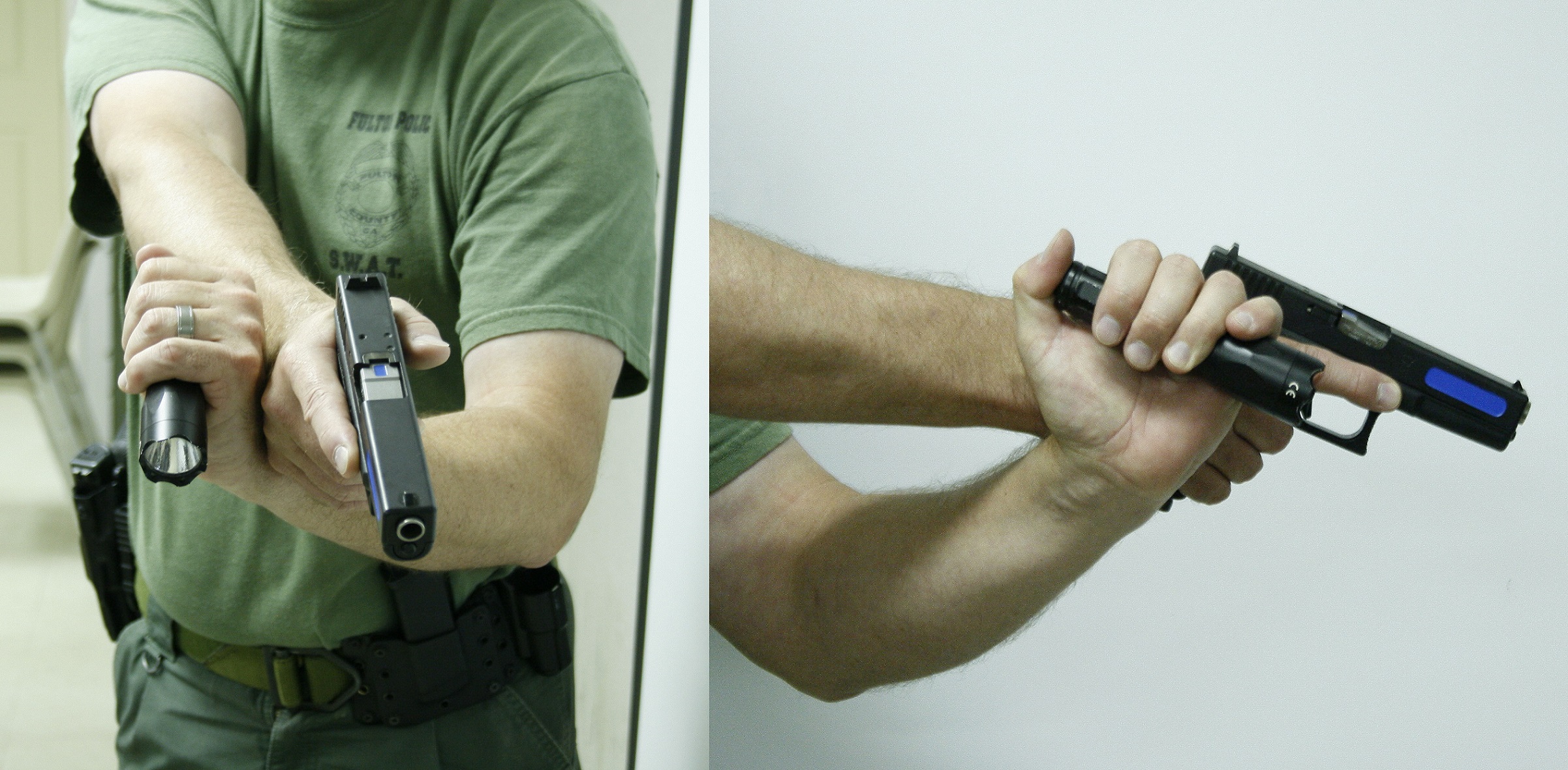
Common hands-together technique. Having hands crossed under stress can lead to hand confusion, where a signal to contract muscles to activate the light can result in a contraction of the trigger finger. Using this technique, we should keep the light on — not press-and-release.
Enough of the moles already, let’s take a quick look at the other UDs in the experiment. Since the students could not remember precisely what happened, I will give the circumstances and then my conclusions. In the next instance, the student had already entered the dark hallway. Several seconds into the darkness, the weapon fired. Immediately following the UD, the student’s flashlight illuminated the dark. My educated guess is that when the reaction hand went to manipulate the flashlight holder and grasp the flashlight, the weapon hand also contracted, causing the discharge. I was unable to see if the finger was along the frame prior. This would fall into the realm of the sympathetic response.
In the next instance, the two students were progressing down the dark hallway. The student wearing the camera can be heard breathing heavily. His flashlight was on and directed down the hallway. The student to his left was utilizing the Harries flashlight position (reaction hand crossed under and supporting the weapon hand) and was using a press-and-release technique where the light was on for a few seconds and off for a few seconds. When his light went off, there was a pause, then a UD, then the light came back on. My assessment is that due to the stress of the event and the added complication of crossed hands in the dark, when the brain sent a signal to the support hand to turn on the flashlight, the impulse went to the weapon hand and caused the UD.
The last type of UD was at first a little confusing. The student had her flashlight projecting down the hallway for several seconds. As the flashlight beam came to rest on the first perpetrator (who in the scenario had killed himself), visible and motionless about 25 yards away, the student fired one time. After thoughtful consideration, I believe that this one was also a case of being mentally preconditioned to shoot at the first stimulus of a threat. When the student’s light landed on the person down the hall and she realized it was a person, she fired the weapon.
While this could be classed as a startle effect, I think there’s a little more to it. It is similar (if not identical) to the UDs that occurred as the students entered the hallway and fired in response to the last gunshot. In my opinion, the primary cause was the anticipation of an encounter. The student was expecting to get shot and expecting a pain penalty and thereby preconditioned herself to fire on stimulus rather than taking the time to make a conscious assessment and decision.
Conclusions
This presents an interesting nuance for trainers and warrants further discussion and evaluation. I think that high-stress training is necessary for anyone who carries a weapon. Not only is it useful for building skills and confidence, but also for identifying individuals who may be more prone to certain undesirable behaviors and targeting them for additional training and evaluation. I look forward to reading comments and welcome any input on the matter.
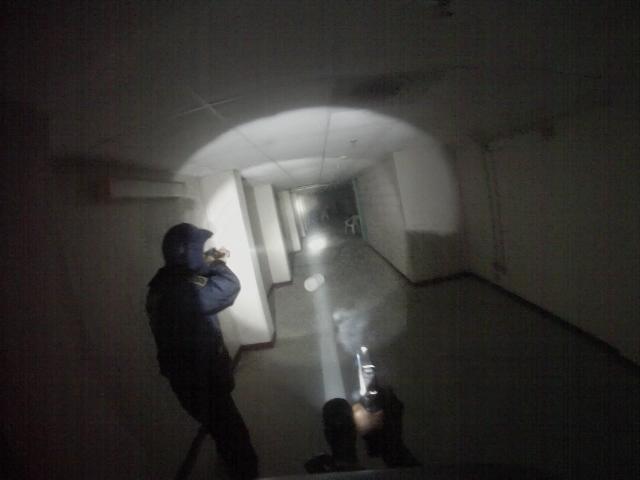
Outstanding article. Thank you. Do you have any suggestions for doing high-stress training as an individual? I work for a service that, for a number of reasons, does not provide continued training.
You are definitely moving into the field of psychoneurological research, and getting some useful results. The formal science may be useful but experiments there often lack the life-threatening aspects of self defense training, and so may not be totally relevant. The main objective seems to be to remove the deliberate discharge (pulling the trigger) away from a conditioned (or habituated) response and into a fully cognitive (deliberate) action. Fear and an attempt at speed will both precipitate such an undesired result (an UD). I've commented on speed but fear/anxiety is another seldom-visited performance inhibitor: anyone training for a lethal encounter (including military and law enforcement) needs to work through the real fact that they are quite likely to be killed, anyway. Until this basic fact is understood, appreciated and accepted there will always be an element of panic in our response to such a lethal encounter. Before we can master the intricacies of actual technique we need to have our basic psychological equilibrium calm and reliable.
While I am not a fan of a mechanical safety on a pistol, I wonder if it would make a difference in preventing unintentional discharges. Have you done any of this training with a pistol with a safety or an AR-15? I also wonder if the brain has already decided to shoot, if the safety, like the finger along the frame, would be irrelevant. Thanks for the great work on this subject.
The artical was interesting with some good insights. In my younger years I had a DI that tought snipers (before the hi technology of today) we learned snap shoot with BB guns to hit targets that were moving and visable for 1 second. The turning on and off of the flashlight gives the bad guy an advantage. You holding the lite have 3 problims, one: you just gave your passion away, two: you just provided an aim point for the bad guy, three: by the time your eyes have adjusted to the dark or from dark to light, you could be dead. As you progress down the hall you will display a patern of when and for how long your light will be on, that makes you a liability. We learned to not use flashlights, at the end of my training I could see in the dark. When one can see the things that are darker than the night , a flashlight in the other persons hand is to your advantage. Just for funn use simnitions or paintball, be blindfolded, have a clicker behind a target and see if you can even hit the paper. When one is in an adversel situation the person you are chacing allways has the advantage, unless they are really dumb, lucky for us the Perps of today are. Learn to use ALL your séances , not the few in training. When I hunt I can smell the pray, feel it, see it, hear it, and anticipate what it will do or go. Going after a purp is no different other than you are hunting a human being. Dead is dead eather you or them. Stay safe fully alert at all times, complacency kills.
I can see how all of these could happen with out a lot training in high stress. Being able to train this way is almost non existant unless you have a way to practice this. A friend of mine has tried to set up a system like this at the out door range with paint ball guns. They hurt also. This is very good. thank you. We had quite a few UD's. Keith Greenwood/Sioux Bullets
Very interesting. I would like to see an evaluation of what happened, when you see several police officers firing many rounds at a single person, that may have only a knife.
I have been interested the effects of sympathic fire and unintended fire for quite some time. (Re the Kiesha Miller, Riverside CA. case in which 4 officers were fired due to this effect) Your study is the best I have seen on this subject. I am intrigued by the hypothysis that trigger finger placement prior to the shot has little to do with the unintended shot. In fact your brain has already prepeogramed the shot in anticipation of survival. It is definitely something we must train for since our brains full time job is in fact "survival"! Keep up the good work, John, Retired LEO, POST certified firarms instructor
High stress training is a must for anyone who owns a gun. It builds confidence and skill level to a higher level. This approach for gun training is a must in today society.